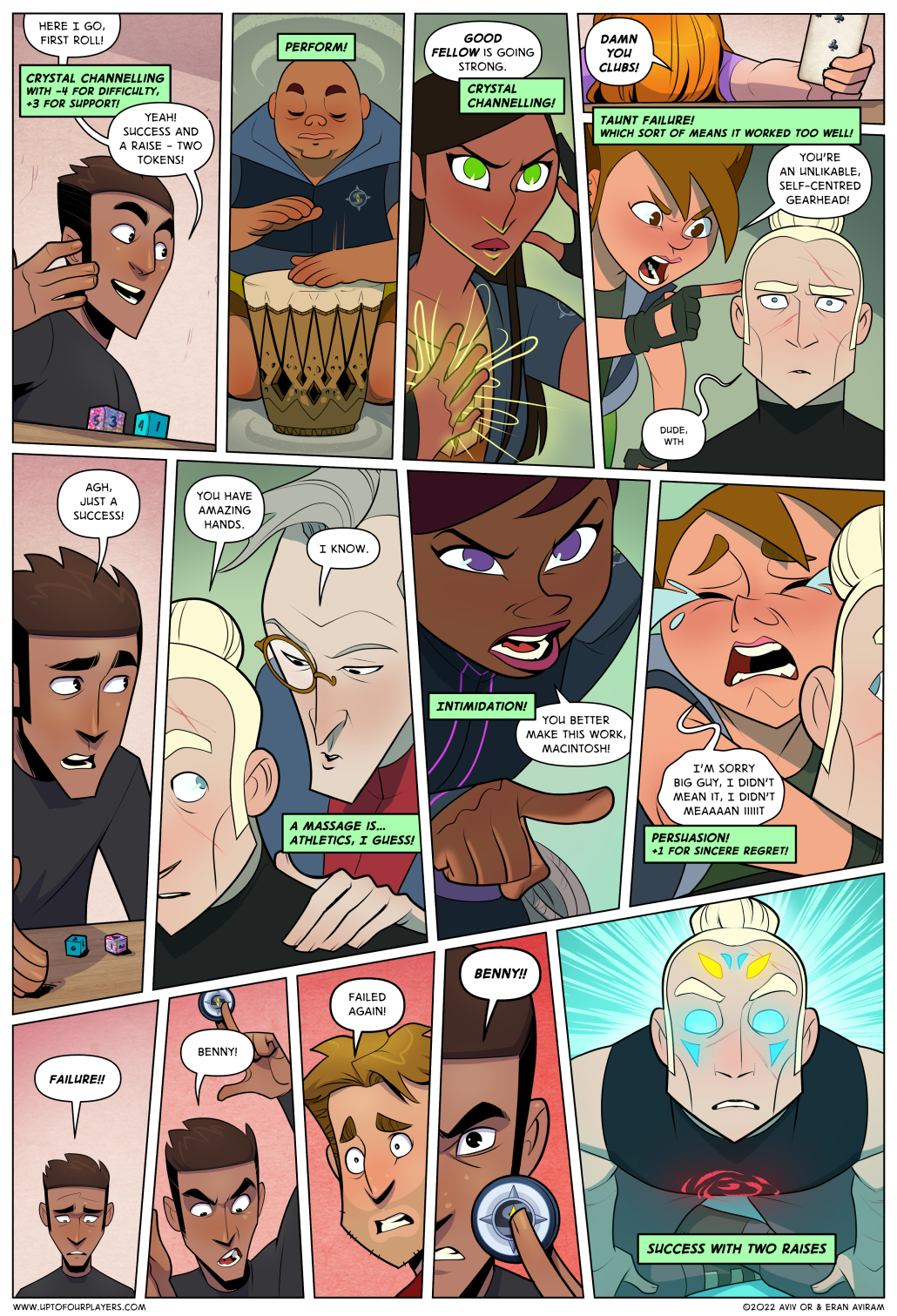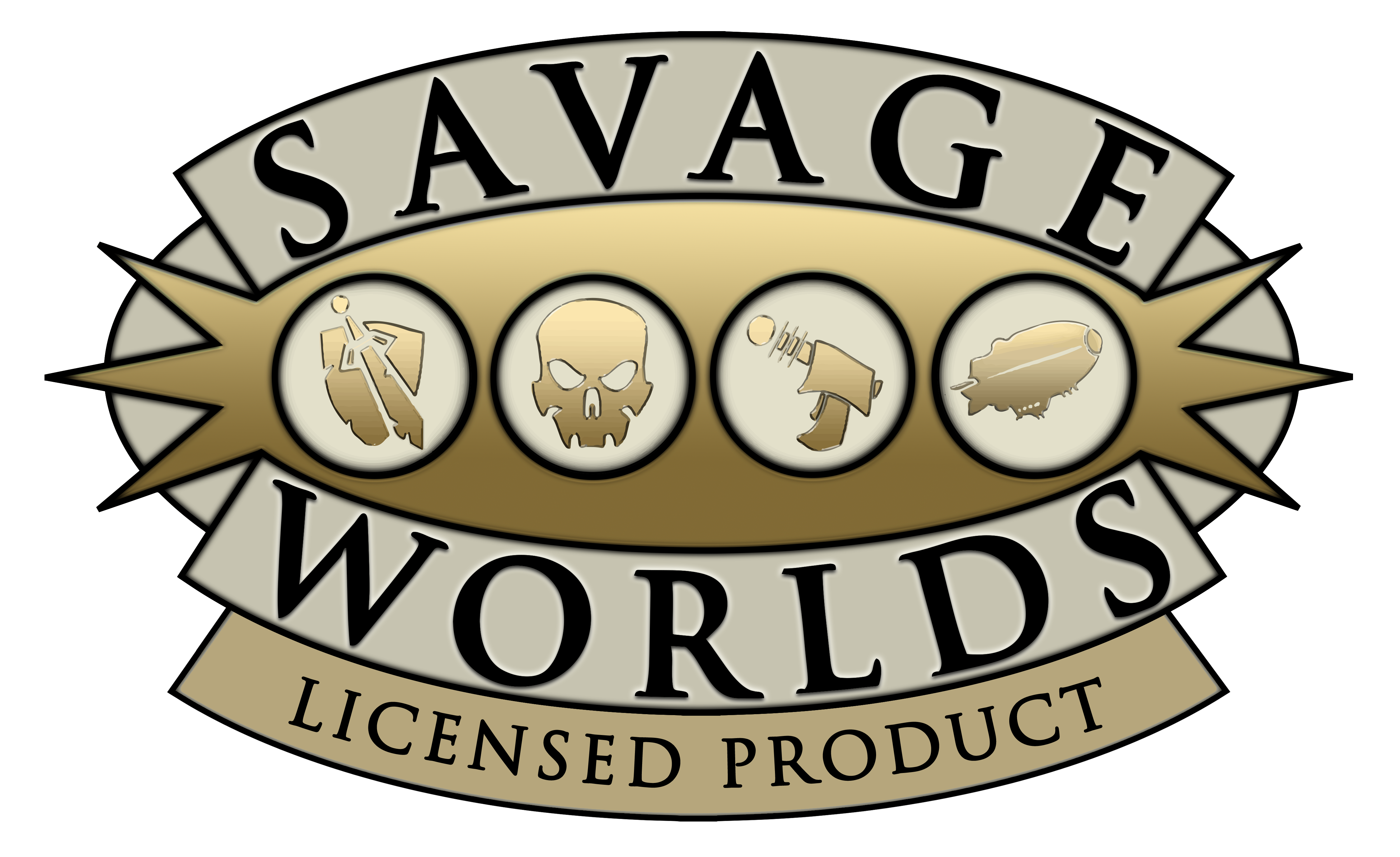Bennies have such an incredible tension potential, and to think I disliked them at first because they’re “like cheating”. In our D&D 5e group (running Zeitgeist) we replaced Inspiration with Bennies. In the big roleplaying game I develop, Bennies-equivalent are built-in, even though it uses cards. Giving the players a chance to influence the roll after the roll – but keeping its availability very limited – is soooo good.
I’ve been asked to discuss something I’ve talked about on page 32, when the turtle doctor became a Size 4 turtle doctor: “I’ve got a lot to say about this page, but I can’t talk about it yet, so remind me to get into a long rambling about GM planning when this fight is over”. Vinkali on our Discord reminded me.
The following long rambling is about codifying metaphysics – how to decide when to do it.
Let’s establish definitions: “codifying” (or canonising) is the act of deciding that a fact is true in the fictional world, and from this point on, it’s expected to be consistent. “Metaphysics” are the rules of the world, and actually it’s just its physics, it’s just how things work. But we call it metaphysics because it’s about all the invented aspects of that world’s physics, everything that’s different from real-world physics. If you wanna, you can call it “how magic works”, but I dislike the use of the word “magic” because it’s ambiguous.
My claim is that timing is incredibly important when we talk about codifying, and that we should leave the bulk of the codifying – specifically, interactions – to be decided during the game, not beforehand. Just like we should do with almost everything else in RPGs, btw. I only bring this up because I think many GMs, when they put on the worldbuilder hat, may put too much emphasis on creating everything before the game begins, thinking that they need to have “a full picture of how magic works”. I think they need a firm grasp of some core pillars, which will guide them in making decisions during the game.
Some people might buckle at this, because these decisions are about things that “have always been true”, and so, “should be decided as early as possible”, because the concept of truth going retroactively annoys them. But I would say that this is kind of perception is a hindrance to a good tabletop game in 98% of the cases, and that the skill of accepting and enjoying retroactivity (and it is a skill) should be learned by all. I have talked in the past about the usefulness of retroactive decisions, and I think that metaphysics are not exempt from that, even though they seem to be “more essential” because they are seemingly literally the basis for everything else. They’re not; it’s all fiction and all fiction is equally untrue; the experience around the table is the true basis for everything else.
Let’s see Nadav in action:
Ever since the beginning, Nadav knew what Crystals were. The complete story behind them is still unclear to you, readers, but we know they’re the condensed essence of some Beasts of the previous age (sort of). He decided that they have a “radiation” of a sort, they’re dangerous at close range and especially when touched. Nadav also knew he want to have Life Abundance Zones, places that Syn forbids you to go into, and that can reveal the Beast. He wasn’t sure yet why they exist, in the metaphysical sense, he just wanted them to exist for the narrative reason of forcing the players to see the hidden truth. He didn’t at all think about how these zones affect non–Agents, or how they interact with Crystals.
Then the first adventure happens, and establishes that at least one specific Crystal – the red Beast – can make non-Agents into sort-of-Beasts. Later, Life Abundance Zones happen, and establish that only Agents are affected by them (well, sort of, you’ll see). These two things must be related somehow, right? Yeah, but not sure how. Nadav figured each of these will help him establish what the other can do. Note that until these things happen, during the game, none of this is “true”, and Nadav actually had 2-3 thoughts about what might be the case, finally deciding on one right before or even during the session.
Now, the current adventure happens. Our Agents discover a person who used the liquid of the Crystal Beast to become a real Beast. “This liquid is basically a potion of turn-to-Beast.” Nadav decides, but he also wants the doctor to be the only clever Beast around, he doesn’t want an influx of Bygone Era legends running around. He didn’t really expect the players to engage with her as they do, so he quickly thinks – I need an arsenal of cool dangers, in case this becomes a fight scene, so how about instead of just some human guards, she can spray the red liquid and make all the normies around into crazed Beasts. Like with those werewolf dudes. This makes her more sinister, so sure, that works well.
So now he needs some explanation as to why sometimes the liquid makes you crazed and sometimes it makes you super-clever. He goes for the obvious reason – the former is an Extra and the latter is a Wild Card. Not everything has to be absolutely explained with in-world reasoning, consistency is the more important issue. Later, when he realises that Kitau (who is by now a WC, despite not being one when she was first introduced) might want to keep some of the liquid and use it at a later date, he adds a bit of flair and risk by introducing a Spirit check. The final version is summarised in this post.
But the real bomb hits when Dr. Dudaha is thrown into the Crystal Beast. When an Agent touches a Crystal, they might suffer a desync, because the two Crystals clash; when a non-Agent human touches Crystals, they might transform or something, like a mutation; but what happens when a Beast touches a Crystals? AHHH, a new interaction.
Nadav now uses three tools to decide what will happen.
- It should be consistent with what we already know about the world. (you might say “obviously”, keen reader, but do remember that what’s obvious to you, might not be to others)
- It’s best to use Occam’s Razor as a rule of thumb, and attempt to create the least amount of entities and interactions (because it’s easier for everyone and supports a healthier narrative skeleton). So, it shouldn’t be something very new, like the turtle turning into a fox (Beasts can now change their essence!!) or her becoming a demon (There are demons in this world!!)
- It should fit the tension level of the current scene. This guideline isn’t more important than the other two, but it’s more prominent.
So the first thing Nadav tries to do is satisfy #3. The best thing to happen now is to escalate the fight, this is Savage Worlds after all, and we’re suffering from a deficiency of giant monsters! So that really should happen. To make sure that it fits with #2, he decides that she sort of loses her mind – in essence, like what already happens to Extras when they get red Beast liquid. To satisfy #1, and keep some wiggle room, he decides that this is true for this Crystal, and not necessarily all Crystals. After all, the whole shtick of this Crystal is about Beasting-up, so it makes sense for it to Beast-up-up, but there’s no telling what will happen if a Beast touches, let’s say, Survivor.
Actually, now that a Beast-Crystal interaction is brought up, what do the Beasts themselves think of Crystals? Aren’t Crystals, like, sort of dead half-Beasts? Nadav will have to decide on this very soon. Like, next page, it seems.




